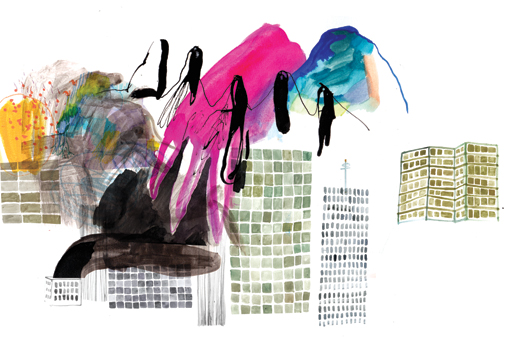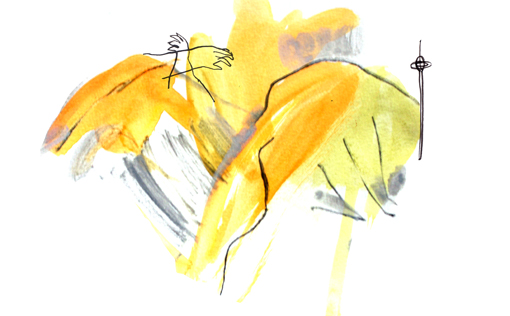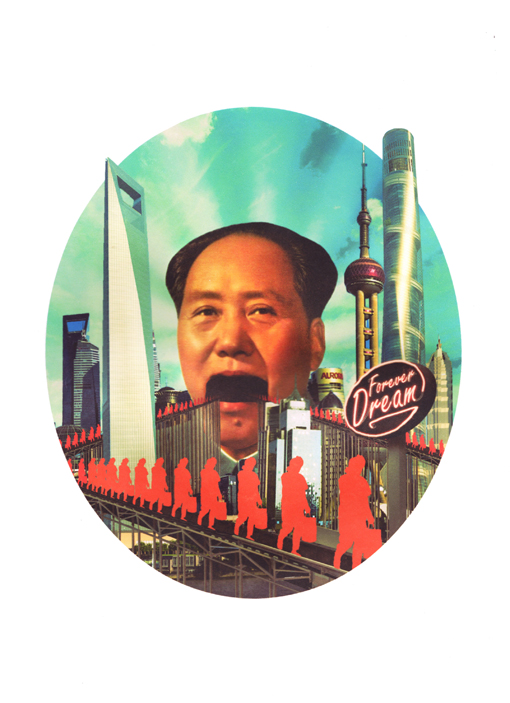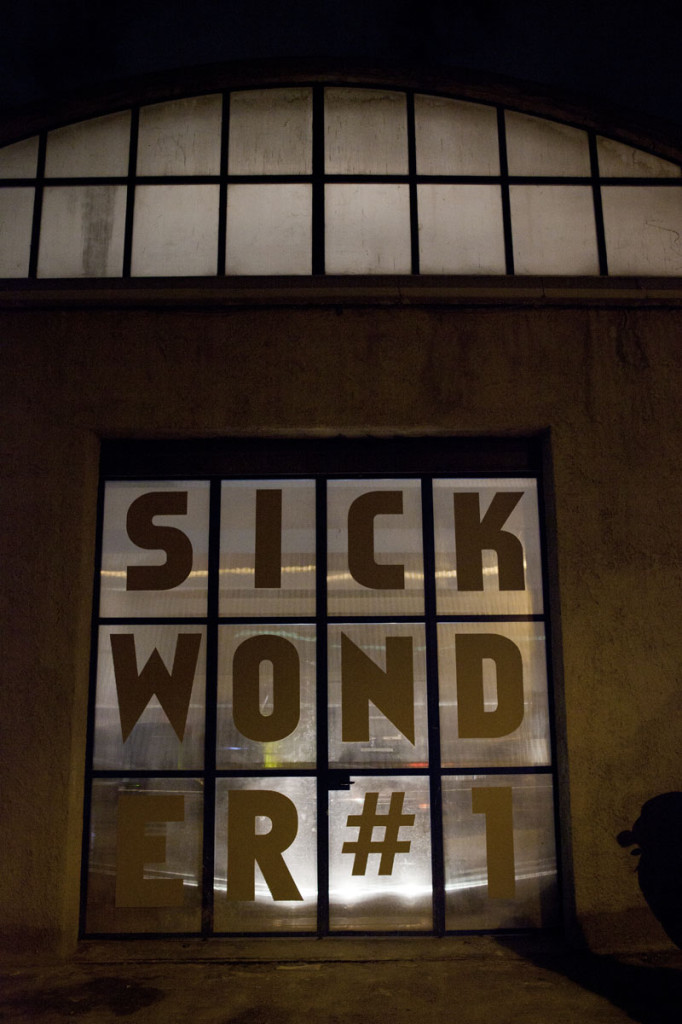GRAND BAZAAR

text Golnaz Ebrahimi illustrations Eleanor Meredith
It’s snowing, the white blanket lies on the grayness of the city and illuminates it. Everything is white and it seems that the air is finally breathable; there is no longer the need to take the car and run away from it in order to finally breathe.
The clouds were a secret desire in each of us: the sign that we would soon be able to get out and experience the city: run, play lightheartedly and laugh under the snowflakes that would soon fall. Finally living the city in its fullest without having to worry about breathing.
Today the air in Tehran kills 26 people a day.
The city has exploded going from the 200 thousand inhabitants of the early twentieth century to the 12 million of today. It underwent a period of intense Westernization in order to compete with other developed countries but became an illogical disarticulated urban agglomeration, a copy impossible to interpret. Western architectures were imported as objects of consumption and Tehran is now a deposit-city separated from its context.
It’s frenetic development has failed to fulfill one of the principles of contemporary Architecture : to serve the community and it’s individuals. An incredible metropolis, which has ruthlessly taken control of the territory, engulfing it without limitation, the only barrier to this viral expansion is it’s sublime mountain chain of over 5000 m. Most of the old part of the city is being constantly mutilated and new constructions are replacing the old, which do not relate and do not respect the place where they were born; thus you can come across an anonymous building of 30 floors next to a delightful house with a garden, lost in an unstable mass. Each proportional rule and good common sense is subverted in the name of profit and progress.
The intricate mega-highways, in which the gaze is lost for miles until it meets a small oasis of green, decorated with flowers and low bushes that give a hint of color and can warm the soul, although briefly, while you are stuck in the everyday traffic. The lack of footpaths and pedestrian areas makes it almost impossible to go out for a walk, life takes place mostly in closed or private spaces. This is due to cultural reasons as Islamic architecture was based more on interior spaces, although in the last century it has undertaken more public spaces, the tradition and the frenetic expansion of the city has effectively limited these experiences.
Far from the gray mass of pollution and desolation you can immerse yourself in a forest of slender plane trees whose foliage tells of a different past.
The Niavaran Palace is one of the wonders of the city.
Oppressed citizens quietly trample on the carpet of autumn colored leaves, finding an intimate aspect which they imagined lost forever. Roaming slowly, for the sake of roaming in silence, away from the noise and roar of the city that invests everything. And rediscovers a smile.
Tehran is located over one of the largest Asian fault lines, most of the buildings were thus built in seismic areas without any consideration about their safety. They have erected luxurious buildings for unaware buyers who are attracted by the dream of a promising life, but in fact ignore the mortal danger of their homes and offices. Who knows how long this system will stand as only a small part of the building is constructed with anti-seismic criteria.
Bahram Akasheh Iranian geophysicist and seismologist, has tried several times to warn the administration of the danger caused by the uncontrolled expansion of the city, proposing to move the capital to another place, but unfortunately has not been listened to. The Grand Bazaar of Tehran is one of few places which truthfully shows the origins and culture of this country. three kilometers long with more than 20 000 stores it is one of the largest markets in the world.
It is a city within a city, full of shops, mosques, squares and buildings, passing through the corridors under arches and domes in brick and plaster you can feel the origin of Persian art and architecture.
Walking between the people , immersed in what used to be the atmosphere of not long ago you can finally feel alive, rediscovering the sense of spontaneity which is lost in the noise, traffic and pollution of the streets.
In addition to the exceptional visual experience, you can perceive smells, colors, and touch objects and materials, the bazaar is a space to perceive life with all your senses, said Juhani Pallasmaa:
[...]”Every touching experience of Architecture is multi-sensory; qualities of space, matter and scale are equally measured by the eye, ear, nose, skin, tongue, skeleton and muscle[...] In Tehran, the only consolation is a glorious and wonderful past, on which lay the basis for a future which will hopefully be enormously different from the present.

Nevica, la coltre bianca si stende sul grigiore della città illuminandola. Tutto è bianco, sembra che l’aria sia finalmente respirabile, non è più necessario prendere la macchina e scappare lontano da Lei per poter finalmente respirare.
Le nuvole erano il desiderio segreto di ognuno di noi: il segnale che presto si sarebbe potuti uscire e vivere la città: correre, giocare spensierati e ridere sotto i fiocchi che sarebbero scesi di lì a poco. Finalmente si viveva la città nella sua pienezza senza doversi preoccupare di respirare.
Oggi l’aria a Teheran uccide 26 persone al giorno.
La città è esplosa passando dai 200 mila abitanti dei primi del novecento ai 12 milioni di oggi. Ha subìto un periodo di occidentalizzazione intenso al fine di competere con gli altri paesi sviluppati ed è diventata un agglomerato urbano disarticolato e illogico, una copia priva di interpretazione. Le architetture occidentali sono state importate come oggetti di consumo e Teheran è oggi una città-deposito. Deposito di un’Architettura svincolata dal suo contesto.
Il suo frenetico sviluppo ha disatteso uno dei principi dell’Architettura contemporanea: porsi al servizio della collettività e dell’individuo.
Una metropoli incredibile, che si è appropriata senza regole del territorio fagocitandolo senza limiti, se non fosse per la sublime catena montuosa di oltre 5000 metri che la circonda; unico freno alla sua espansione virale.
Le parti più antiche vengono continuamente mutilate e sostituite da nuove costruzioni, che non si relazionano e non rispettano il luogo in cui nascono; così accade di vedere un anonimo edificio di 30 piani accanto ad una deliziosa casa con giardino, persa nella marea instabile.
Ogni regola proporzionale e di comune buon senso è sovvertita in nome del profitto e del progresso.
Un intreccio di mega-autostrade, nelle quali lo sguardo si perde per chilometri fino a quando non incontra piccole oasi di verde, decorate con fiori e cespugli bassi che regalano un pizzico di colore e riescono a scaldare l’anima, seppur brevemente, mentre si è imbottigliati nel traffico quotidiano. La mancanza di marciapiedi e zone pedonali rende pressoché impossibile uscire a piedi e la vita si svolge perlopiù in spazi privati o chiusi. Questo anche per ragioni storiche visto che l’architettura islamica era volta principalmente agli spazi interni, e sebbene nell’ultimo secolo si sia occupata sempre più degli spazi pubblici, la tradizione e la frenetica espansione della città hanno di fatto limitato queste esperienze.
Voltando le spalle al grigiore e alla desolazione è possibile immergersi in una selva di slanciatissimi platani che con le loro chiome raccontano un passato diverso.
Il palazzo di Niavaran rappresenta una delle meraviglie della città.
Cittadini oppressi silenziosamente calpestano in autunno il tappeto di foglie colorate, ritrovando una dimensione intima che immaginavano persa per sempre. Vagano lentamente, per il gusto di vagare, in silenzio, lontani dal rumore e dal rombo della città che tutto investe. E ritrovano il sorriso.
Tehran è situata sopra una delle più grandi faglie asiatiche, la maggior parte degli edifici è stata costruita dunque in zona sismica senza tenere in alcun conto la sicurezza. Vengono eretti edifici lussuosi per ignari acquirenti, attratti dal sogno di una vita rosea, che di fatto però non conoscono la pericolosità mortale delle loro case e dei loro uffici. Chissà quanto questo sistema reggerà visto che solo una piccola parte delle costruzioni è costruita con criteri anti sismici.
Bahram Akasheh geofisico e sismologo iraniano, ha cercato varie volte di avvertire l’amministrazione del pericolo causato dall’espansione incontrollata della città, proponendo di spostare la capitale in un altro luogo, ma purtroppo non è stato ascoltato.
Il grande Bazar di Tehran è uno dei pochi luoghi che narrano delle origini e della cultura di questo Paese. Lungo tre chilometri con più di 20 mila negozi è uno dei più grandi mercati del mondo. È una città nella città, ricco di negozi, moschee, piazze e palazzi; passeggiando nei suoi corridoi sotto volte e cupole in mattoni e gesso si è totalmente immersi nell’arte e nell’architettura persiana. Camminando tra la gente ci si immerge in quella che doveva essere l’atmosfera di non molto tempo fa, e finalmente ci si sente vivi, riscoprendo quel sentimento di spontaneità che nelle strade si perde a causa del rumore e dell’inquinamento.
Qui si riesce a sentire la città fin nel profondo.
Oltre alla formidabile esperienza visiva, si possono sentire odori e toccare con mano oggetti e materiali, il bazar è uno spazio che fa percepire la vita in tutti i sensi.
Dice Juhani Pallasmaa: [...]” Ogni esperienza tattile dell’Architettura è esperienza multi-sensoriale; qualità spaziali, materiale e scala sono misurabili ugualmente attraverso occhio, orecchio, naso, pelle, lingua, scheletro e muscolo.[...]
A Teheran l’unica consolazione offerta è un glorioso e meraviglioso passato, sul quale porre le basi per un futuro che sia diverso dal presente.
Related Posts :
Category: Article
Views: 5576 Likes: 4
Tags: cityvision mag , Eleanor Meredith , Golnaz Ebrahimi , Sick & Wonder , tehran
Comments:
Info:
Info:
Title: GRAND BAZAAR
Time: 6 marzo 2013
Category: Article
Views: 5576 Likes: 4
Tags: cityvision mag , Eleanor Meredith , Golnaz Ebrahimi , Sick & Wonder , tehran






